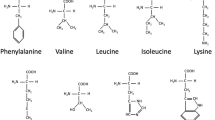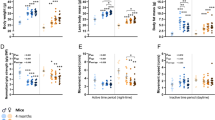Abstract
In a previous study, we reported lower sarcoplasmic reticulum (SR) Ca2+ pump ionophore ratios in rat soleus compared to red and white gastrocnemius (RG, WG) muscles which may be indicative of greater SR Ca2+ permeability in soleus. Here we assessed the lipid composition of the SR membranes obtained from these muscles to determine if SR docosahexaenoic acid (DHA) content and fatty acid unsaturation could help to explain the previously observed differences in SR Ca2+ permeability. Since we have shown previously that sarcolipin may also influence SR Ca2+ permeability, we also examined the levels of sarcolipin in rat muscle. We found that SR membrane DHA content was significantly higher in soleus (5.3 ± 0.2 %) compared to RG (4.2 ± 0.2 %) and WG (3.3 ± 0.2 %). Likewise, total SR membrane unsaturation and unsaturation index (UI) were significantly higher in soleus (% unsaturation: 59.1 ± 2.4; UI: 362.9 ± 0.8) compared to RG (% unsaturation: 55.3 ± 1.0; UI: 320.9 ± 2.5) and WG (% unsaturation: 52.6 ± 1.1; UI: 310. ± 2.2). Sarcolipin protein was 17-fold more abundant in rat soleus compared to RG and was not detected in WG; however, comparisons between soleus, RG, and WG in sarcolipin-null mice revealed that, in the absence of sarcolipin, ionophore ratios are still lowest in soleus and highest in WG. Overall, our results suggest that SR membrane DHA content and unsaturation, and, in part, sarcolipin expression may contribute to SR Ca2+ permeability and, in turn, may have implications in muscle-based metabolism and diet-induced obesity.




Similar content being viewed by others
References
Bal NC et al (2012) Sarcolipin is a newly identified regulator of muscle-based thermogenesis in mammals. Nat Med 18:1575–1579. doi:10.1038/nm.2897nm.2897
Bombardier E et al (2013a) Sarcolipin trumps beta-adrenergic receptor signaling as the favored mechanism for muscle-based diet-induced thermogenesis. FASEB J 27:3871–3878. doi:10.1096/fj.13-230631fj.13-230631
Bombardier E, Smith IC, Vigna C, Fajardo VA, Tupling AR (2013b) Ablation of sarcolipin decreases the energy requirements for Ca2+ transport by sarco(endo)plasmic reticulum Ca2+ -ATPases in resting skeletal muscle. FEBS Lett 587:1687–1692. doi:10.1016/j.febslet.2013.04.019S0014-5793(13)00305-0
Cullis PR, de Kruijff B (1979) Lipid polymorphism and the functional roles of lipids in biological membranes. Biochim Biophys Acta 559:399–420
Dalton KA, East JM, Mall S, Oliver S, Starling AP, Lee AG (1998) Interaction of phosphatidic acid and phosphatidylserine with the Ca2+ -ATPase of sarcoplasmic reticulum and the mechanism of inhibition. Biochem J 329(Pt 3):637–646
Delarue J, LeFoll C, Corporeau C, Lucas D (2004) N-3 long chain polyunsaturated fatty acids: a nutritional tool to prevent insulin resistance associated to type 2 diabetes and obesity? Reprod Nutr Dev 44:289–299
Duhamel TA, Green HJ, Stewart RD, Foley KP, Smith IC, Ouyang J (2007) Muscle metabolic, SR Ca(2+)—cycling responses to prolonged cycling, with and without glucose supplementation. J Appl Physiol 103:1986–1998. doi:10.1152/japplphysiol.01440.2006
Fajardo VA, McMeekin L, LeBlanc PJ (2011) Influence of phospholipid species on membrane fluidity: a meta-analysis for a novel phospholipid fluidity index. J Membr Biol 244:97–103. doi:10.1007/s00232-011-9401-7
Fajardo VA et al (2015) Dietary docosahexaenoic acid supplementation reduces SERCA Ca transport efficiency in rat skeletal muscle. Chem Phys Lipids. doi:10.1016/j.chemphyslip.2015.03.001
Fiehn W, Peter JB, Mead JF, Gan-Elepano M (1971) Lipids and fatty acids of sarcolemma, sarcoplasmic reticulum, and mitochondria from rat skeletal muscle. J Biol Chem 246:5617–5620
Folch J, Lees M, Sloane-Stanley GH (1957) A simple method for the isolation and purification of total lipides from animal tissues. J Biol Chem 226:497–509
Gamu D, Bombardier E, Smith IC, Fajardo VA, Tupling AR (2014) Sarcolipin provides a novel muscle-based mechanism for adaptive thermogenesis. Exerc Sport Sci Rev 42:136–142. doi:10.1249/JES.000000000000001600003677-201407000-00007
Gould GW, McWhirter JM, East JM, Lee AG (1987a) A fast passive Ca2+ efflux mediated by the (Ca2++Mg2+)-ATPase in reconstituted vesicles. Biochim Biophys Acta 904:45–54
Gould GW, McWhirter JM, East JM, Lee AG (1987b) Uptake of Ca2+ mediated by the (Ca2++ Mg2+)-ATPase in reconstituted vesicles. Biochim Biophys Acta 904:36–44
Gramolini AO, Kislinger T, Asahi M, Li W, Emili A, MacLennan DH (2004) Sarcolipin retention in the endoplasmic reticulum depends on its C-terminal RSYQY sequence and its interaction with sarco(endo)plasmic Ca(2+)-ATPases. Proc Natl Acad Sci USA 101:16807–16812. doi:10.1073/pnas.0407815101
Han X, Gross RW (2003) Global analyses of cellular lipidomes directly from crude extracts of biological samples by ESI mass spectrometry: a bridge to lipidomics. J Lipid Res 44:1071–1079. doi:10.1194/jlr.R300004-JLR200R300004-JLR200
Hendriks T, Klompmakers AA, Daeme FJM, Bonting SL (1976) Biochemical aspects of the visual process. XXXII. Movement of sodium ions through bilayers composed of retinal and rod outer segment lipids. Biochim Biophys Acta 443:271–281
Holloway GP, Green HJ, Tupling AR (2006) Differential effects of repetitive activity on sarcoplasmic reticulum responses in rat muscles of different oxidative potential. Am J Physiol Regul Integr Comp Physiol 290:R393–404. doi:10.1152/ajpregu.00006.2005
Hulbert AJ, Else PL (1999) Membranes as possible pacemakers of metabolism. J Theory Biol 199:257–274. doi:10.1006/jtbi.1999.0955S0022-5193(99)90955-4
Hulbert AJ, Turner N, Storlien LH, Else PL (2005) Dietary fats and membrane function: implications for metabolism and disease. Biol Rev Camb Philos Soc 80:155–169
Lande MB, Donovan JM, Zeidel ML (1995) The relationship between membrane fluidity and permeabilities to water, solutes, ammonia, and protons. J Gen Physiol 106:67–84
Li JJ, Huang CJ, Xie D (2008) Anti-obesity effects of conjugated linoleic acid, docosahexaenoic acid, and eicosapentaenoic acid. Mol Nutr Food Res 52:631–645. doi:10.1002/mnfr.200700399
Lorente-Cebrian S, Costa AG, Navas-Carretero S, Zabala M, Martinez JA, Moreno-Aliaga MJ (2013) Role of omega-3 fatty acids in obesity, metabolic syndrome, and cardiovascular diseases: a review of the evidence. J Physiol Biochem 69:633–651. doi:10.1007/s13105-013-0265-4
Maurya SK, Bal NC, Sopariwala DH, Pant M, Rowland LA, Shaikh SA, Periasamy M (2015) Sarcolipin is a key determinant of basal metabolic rate and its overexpression enhances energy expenditure and resistance against diet induced obesity. J Biol Chem. doi:10.1074/jbc.M115.636878
Metherel AH, Armstrong JM, Patterson AC, Stark KD (2009) Assessment of blood measures of n-3 polyunsaturated fatty acids with acute fish oil supplementation and washout in men and women. Prostaglandins Leukot Essent Fatty Acids 81:23–29. doi:10.1016/j.plefa.2009.05.018
Rossmeisl M et al (2009) Prevention and reversal of obesity and glucose intolerance in mice by DHA derivatives. Obesity (Silver Spring) 17:1023–1031. doi:10.1038/oby.2008.602oby2008602
Ruzickova J et al (2004) Omega-3 PUFA of marine origin limit diet-induced obesity in mice by reducing cellularity of adipose tissue. Lipids 39:1177–1185
Schiaffino S, Hanzlikova V, Pierobon S (1970) Relations between structure and function in rat skeletal muscle fibers. J Cell Biol 47:107–119
Seigneuret M, Devaux PF (1984) ATP-dependent asymmetric distribution of spin-labeled phospholipids in the erythrocyte membrane: relation to shape changes. Proc Natl Acad Sci USA 81:3751–3755
Sforza S, Silipo A, Molinaro A, Marchelli R, Parrilli M, Lanzetta R (2004) Determination of fatty acid positions in native lipid A by positive and negative electrospray ionization mass spectrometry. J Mass Spectrom 39:378–383. doi:10.1002/jms.598
Smith WS, Broadbridge R, East JM, Lee AG (2002) Sarcolipin uncouples hydrolysis of ATP from accumulation of Ca2+ by the Ca2+-ATPase of skeletal-muscle sarcoplasmic reticulum. Biochem J 361:277–286
Smith IC, Bombardier E, Vigna C, Tupling AR (2013) ATP consumption by sarcoplasmic reticulum Ca(2)(+) pumps accounts for 40-50% of resting metabolic rate in mouse fast and slow twitch skeletal muscle. PLoS One 8:e68924. doi:10.1371/journal.pone.0068924PONE-D-13-06335
Stark KD, Lim SY, Salem N Jr (2007) Docosahexaenoic acid and n-6 docosapentaenoic acid supplementation alter rat skeletal muscle fatty acid composition. Lipids Health Dis 6:13. doi:10.1186/1476-511X-6-13
Starling AP, Dalton KA, East JM, Oliver S, Lee AG (1996) Effects of phosphatidylethanolamines on the activity of the Ca(2+)-ATPase of sarcoplasmic reticulum. Biochem J 320(Pt 1):309–314
Stefanyk LE, Coverdale N, Roy BD, Peters SJ, LeBlanc PJ (2010) Skeletal muscle type comparison of subsarcolemmal mitochondrial membrane phospholipid fatty acid composition in rat. J Membr Biol 234:207–215. doi:10.1007/s00232-010-9247-4
Stillwell W, Wassall SR (2003) Docosahexaenoic acid: membrane properties of a unique fatty acid. Chem Phys Lipids 126:1–27
Stillwell W, Jenski LJ, Crump FT, Ehringer W (1997) Effect of docosahexaenoic acid on mouse mitochondrial membrane properties. Lipids 32:497–506
Tsalouhidou S et al (2006) Mitochondrial phospholipids of rat skeletal muscle are less polyunsaturated than whole tissue phospholipids: implications for protection against oxidative stress. J Anim Sci 84:2818–2825. doi:10.2527/jas.2006-031
Tupling R, Green H, Senisterra G, Lepock J, McKee N (2001a) Effects of ischemia on sarcoplasmic reticulum Ca(2+) uptake and Ca(2+) release in rat skeletal muscle. Am J Physiol Endocrinol Metab 281:E224–232
Tupling R, Green H, Tupling S (2001b) Partial ischemia reduces the efficiency of sarcoplasmic reticulum Ca2+ transport in rat EDL. Mol Cell Biochem 224:91–102
Tupling AR et al (2011) Enhanced Ca2+ transport and muscle relaxation in skeletal muscle from sarcolipin-null mice. Am J Physiol Cell Physiol 301:C841–849. doi:10.1152/ajpcell.00409.2010ajpcell.00409.2010
Vasickova L, Stavek P, Suchanek P (2011) Possible effect of DHA intake on body weight reduction and lipid metabolism in obese children. Neuro Endocrinol Lett 32(Suppl 2):64–67
Author information
Authors and Affiliations
Corresponding author
Rights and permissions
About this article
Cite this article
Fajardo, V.A., Bombardier, E., Tran, K. et al. Sarcoplasmic Reticulum Phospholipid Fatty Acid Composition and Sarcolipin Content in Rat Skeletal Muscle. J Membrane Biol 248, 1089–1096 (2015). https://doi.org/10.1007/s00232-015-9822-9
Received:
Accepted:
Published:
Issue Date:
DOI: https://doi.org/10.1007/s00232-015-9822-9




